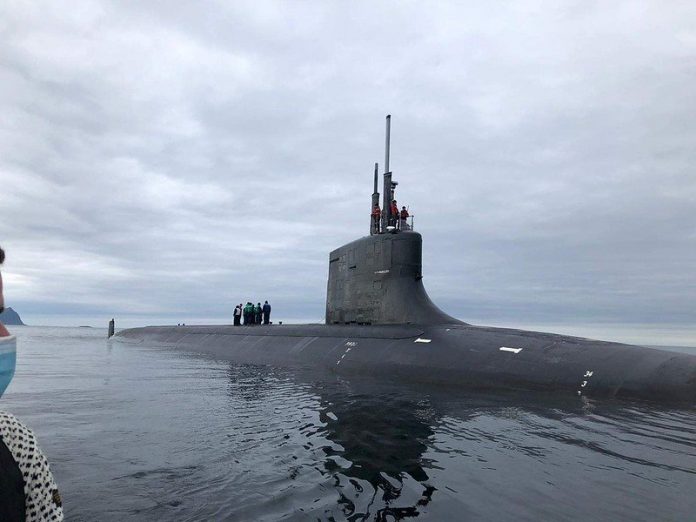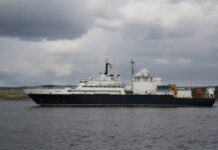
A key Arctic port in Norway has been improved and additions made to pave the way for increased visits by US nuclear submarines, providing a major new jumping off point for watching Russia’s active Northern Fleet as it transits into the North Atlantic, Breaking Defense reports.
Twice over the past year, the US Navy has made public displays of its nuclear submarines docking in Norway, sending a clear signal to Russia about the American presence in the region and providing a rare glimpse into the secretive world or undersea deployments. Of course, Norway would have been asked to approve those releases, sending its own signal to the Russians. But those visits were brief, and mostly for effect. The new work will allow American and NATO submarines to pull into the port and replenish, allowing for longer deployments to the critical Arctic region.
A senior US defense official speaking on background told me, “the US and Norway have a great relationship, and our ability to use facilities in and around Tromso would provide a strategic location for our visits,” which happen about four times a year. “It would give us flexibility for not only the US but allied countries to exercise in the High North.”
Those visits are “a hedge against malign actors in the region,” Cmdr. Kyle Raines, spokesman for US Navy Europe, said. “The US Navy will continue to work closely with the US Embassy and the Norwegian Ministry of Defense to coordinate submarine access to Tromso.”
The work done at Tromso, which sits about 190 miles above the Arctic Circle, has been completed, but local officials are now doing “necessary adjustments and changes to various local regulations and plans,” Marita Isaksen Wangberg, a spokesperson for the Norwegian military told me via email. “This work has to be finalized before nuclear submarines can visit the actual harbor.” Getting the regulations squared away is the last step, as “the physical adaptation of the port facilities has been completed,” Wangberg added.
Tromso has long been a hub of military activity given its proximity to Russia’s Kola peninsula, home to Moscow’s powerful Northern Fleet.
On August 21, the US fast attack submarine USS Seawolf parked off the coast of Tromso to take on new crew members, the Navy acknowledged in a rare statement commenting on the activities of its secretive submarine fleet. The namesake boat of just three Seawolf-class fast attack submarines which specialize in intelligence collection, the Washington-based submarine was likely operating under the Arctic ice before stopping off the coast of Tromso.
Just days before the visit, the Navy also publicized the visit of destroyer USS Roosevelt to Tromso on Aug. 17 as it wrapped up a 50-day patrol in the High North.
“Norway’s support illustrates how much we depend on our NATO allies to conduct at-sea operations,” Capt. Joseph Gagliano, commander, Task Force 65 said in a statement. “Tromso’s support to Roosevelt demonstrates Norway’s commitment to us.”
Likewise, Seawolf’s deployment from Bangor, Wash., to Norway “demonstrates the Submarine Force’s global reach and commitment to provide persistent and clandestine undersea forces worldwide to execute our unique missions,” Navy Vice Adm. Daryl Caudle, the service’s top submarine officer, said in a statement.
Just a day before the Seawolf’s arrival, six B-52 bombers landed in the UK after flying from Minot Air Force Base in North Dakota. The aircraft subsequently flew with the Norwegian air force and passed over each of NATO’s 30 nations in a flyover that clearly caught Moscow’s attention, leading to a series of incidents stretching from the Baltic to the Black seas.
On Aug. 28, a pair of Russian Su-27 jets passed about 100 feet in front of two B-52s over the Black Sea in what US officials described as an “unsafe and unprofessional” pass-by. Days later, another Su-27, flying from Kaliningrad, briefly chased another B-52 into Danish airspace
Just days before these high-flying antics, Russian army vehicles injured seven American soldiers in northern Syria when they rammed US MRAPs in a high-speed chase.
Cold War-style provocations are becoming increasingly common, but the changing face of the port in Tromso will likely have long-lasting strategic effects for NATO and how it operates in the increasingly important Arctic.
“The Seawolf deployment, the joint B-52 flights over Norway last month, and our carrier going north of Arctic Circle for Trident Juncture all speak to a greater show of US presence in the Arctic/High North,” said Rachel Ellehuus, deputy director of the Europe Program at the Washington-based CSIS. “Interestingly, they all had an element of strategic surprise,” she added, “which I’m sure makes our Norwegian allies nervous as they prefer predictability in the region. I’d also note that the US is still behind in fielding some basic capabilities needed to work in an Arctic environment.”
The last publicized US submarine visit to Norway came back in November, when the US 6th Fleet tweeted photos showing MK-48 Advanced Capability torpedos being loaded aboard the USS Minnesota at Haakonsvern Naval Base.
The sub showed up just after 10 Russian submarines were detected moving into the North Atlantic where they conducted live-fire tests while playing a game of cat-and-mouse with US and NATO subs and sub-hunting aircraft.
More changes for the US posture in the High North may be coming. Washington and Oslo are wrapping up a protracted negotiation period meant to update their existing defense cooperation agreement, a document which governs how US forces can posture themselves within the country, and how the two nations will work together military.
Much like the agreement just reached with Poland, the pact will push the relationship between the two countries into the new era of increased aggressiveness by Moscow, which ranges from disinformation campaigns on social media to unsafe fly-bys and other provocations.



